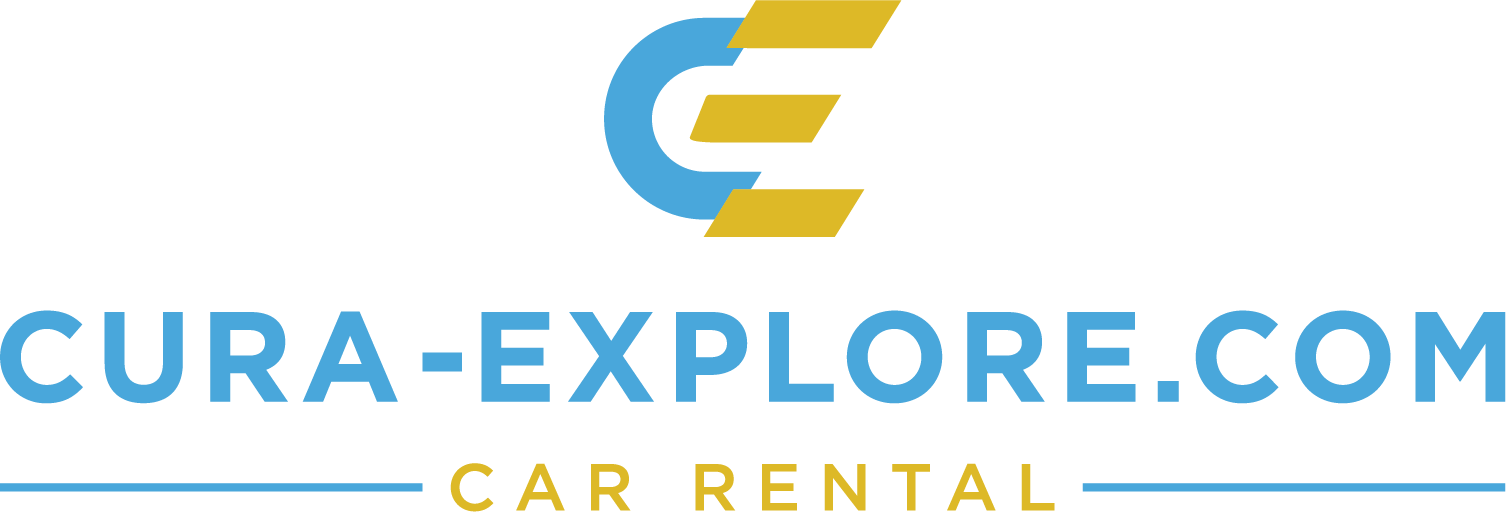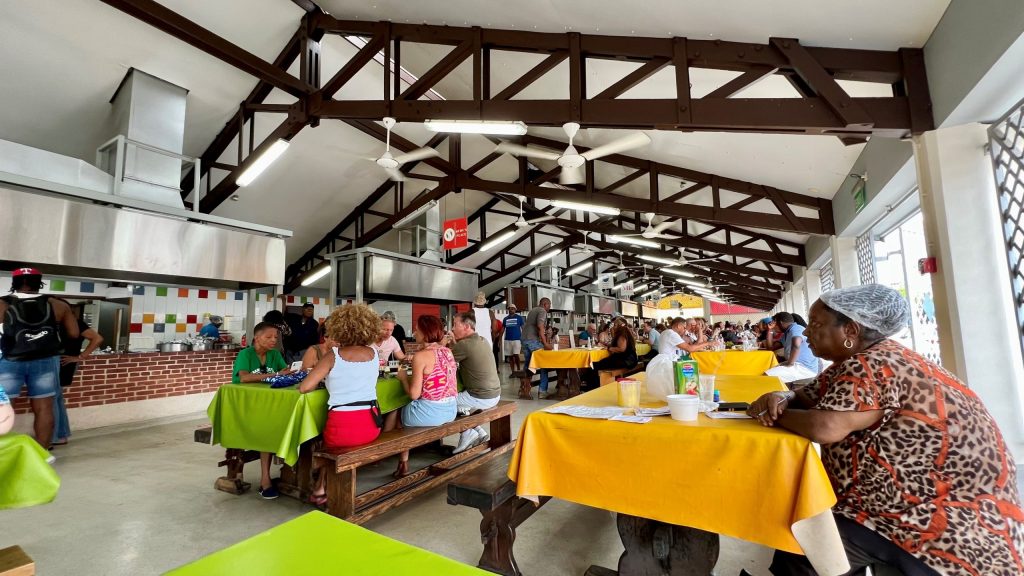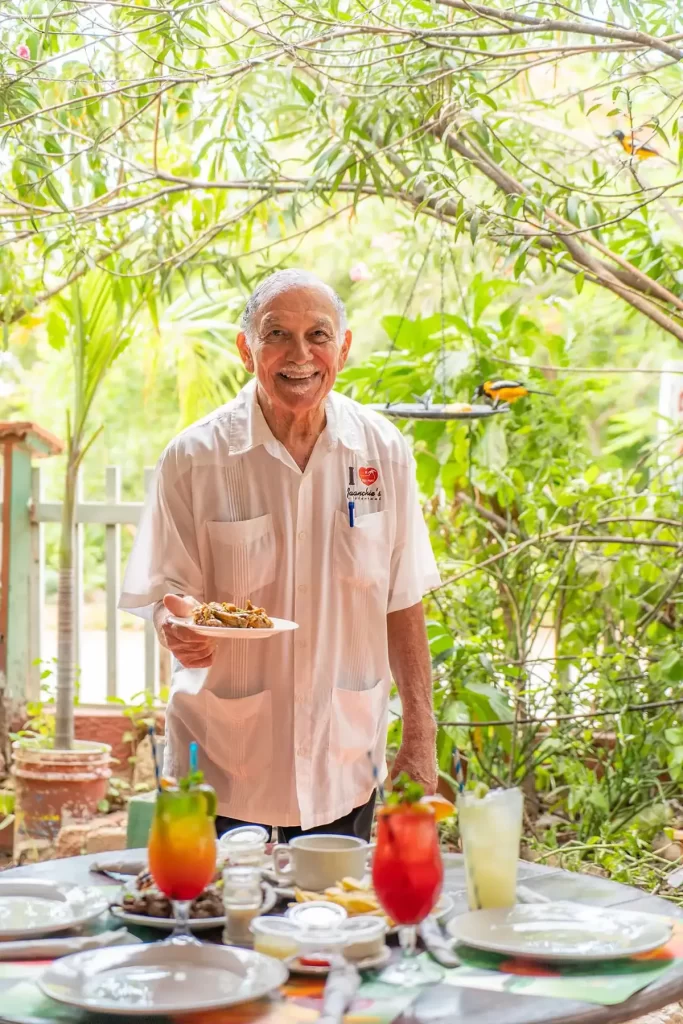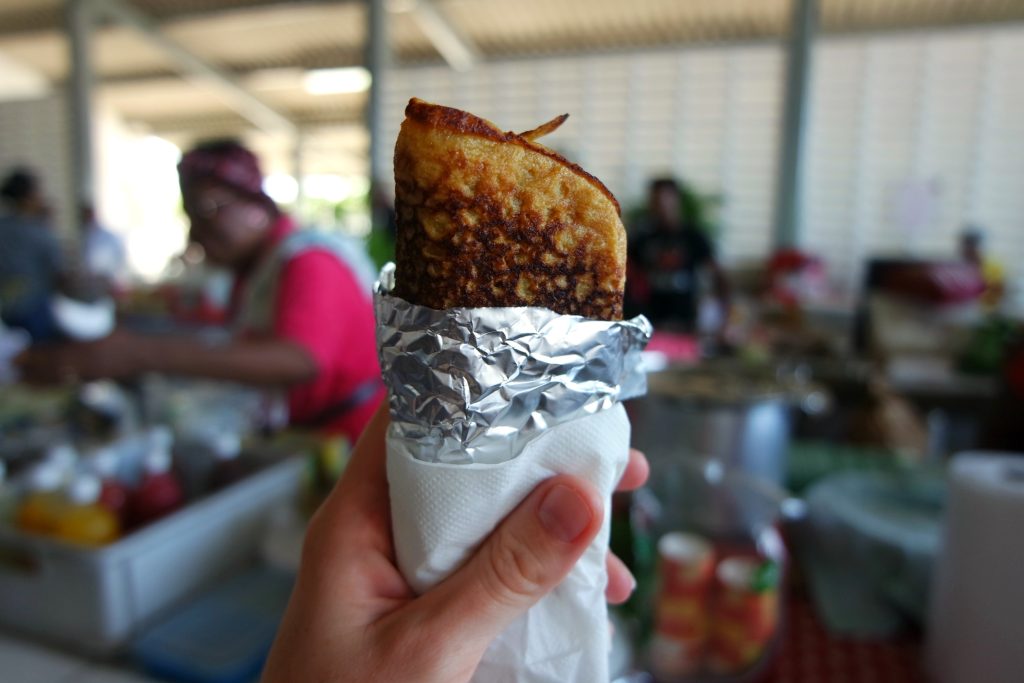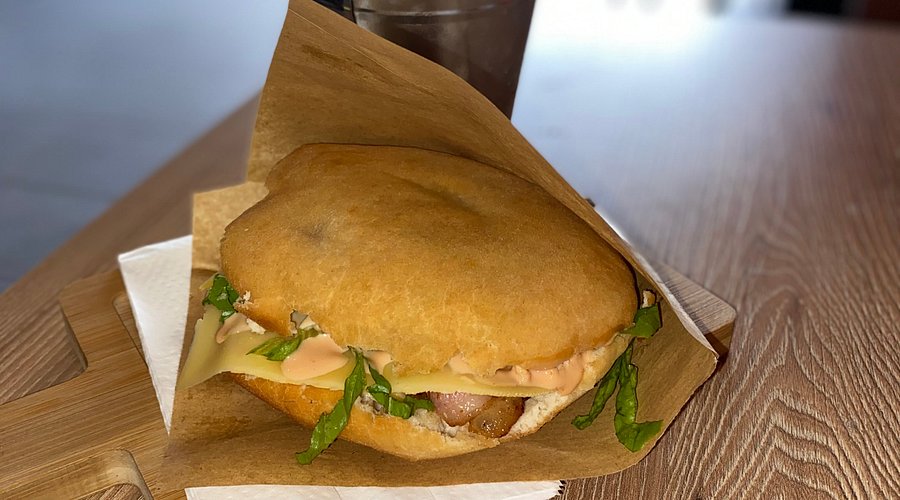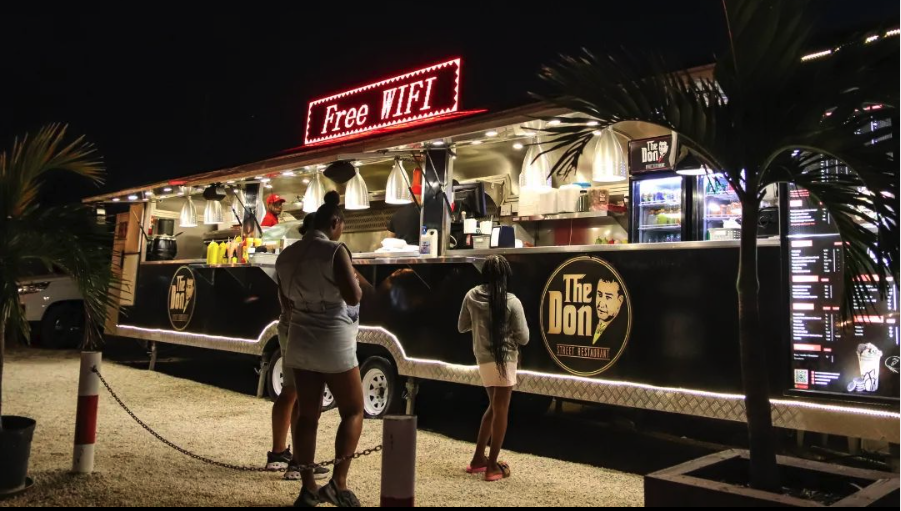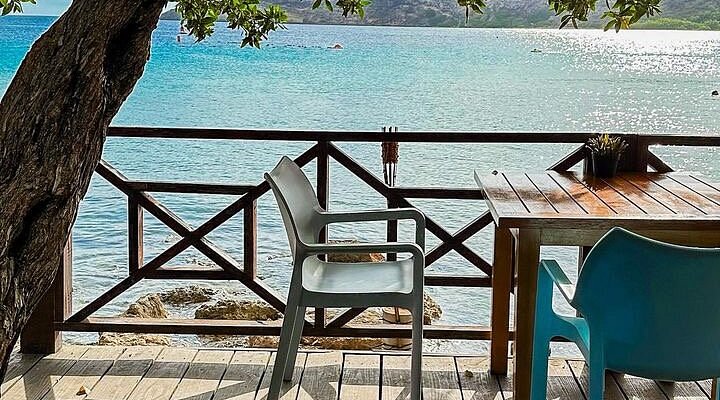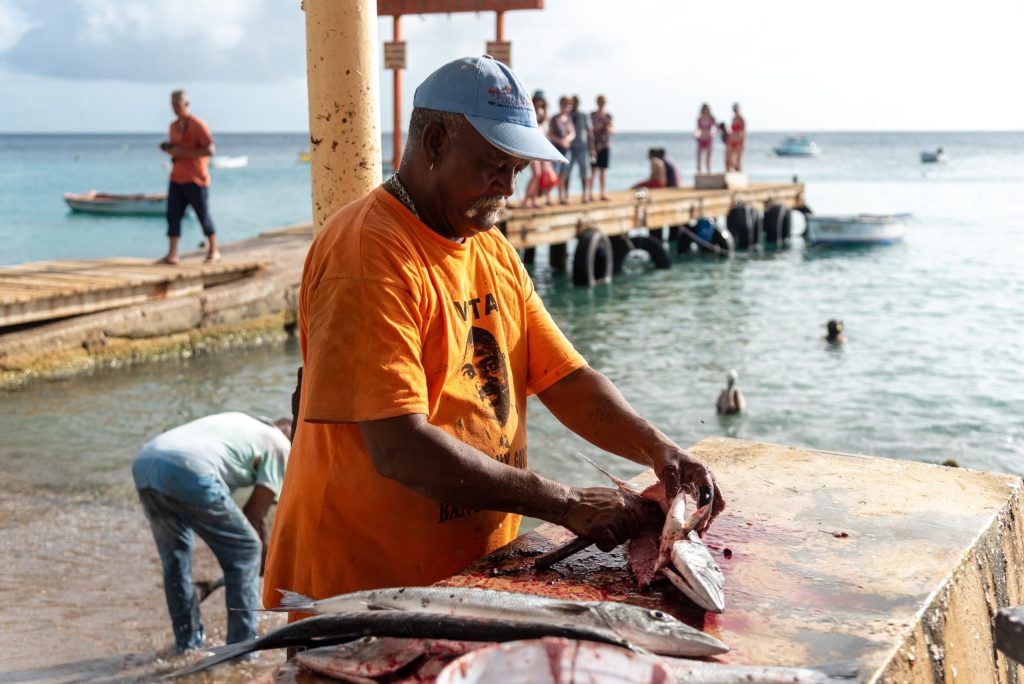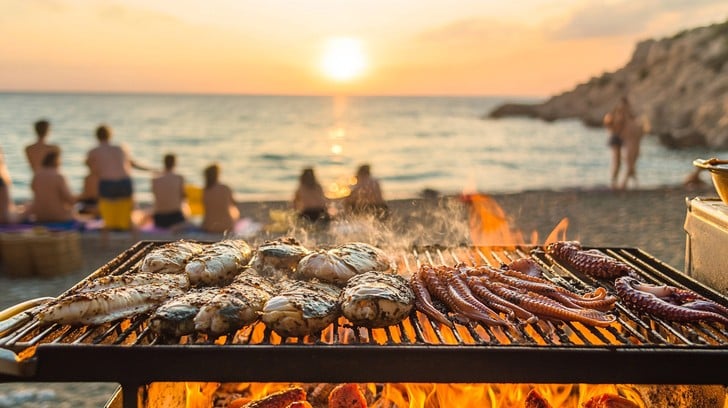1. Plasa Bieu (Old Market, Punda).
Plasa Bieu (aka “Old Market”) is located in Punda, near the Waaigat, and really used to be the place where people from the city came to eat at lunchtime. It is a large, covered hall with several kitchenettes next to each other. Each little kitchen is some kind of family or women’s business that cooks some traditional dishes every day. So you don’t sit at fancy tables with a menu, but at long wooden or metal tables – together with locals, construction workers, office workers and tourists who know where to go.
When you enter, you can just walk past the kitchens. Above or in front of the counter is usually a sign with what’s on that day: kabritu stobá (goat stew), galinja stobá (chicken stew), sopi (soup), kèshi yena (stuffed cheese), funchi, rice, fried banana, sometimes fresh fish. You choose a cuisine, say what you want, and they scoop it right up for you. No hassle, no long waits. It’s mostly homemade food, so what’s gone is really gone.
Opening hours are usually Monday through Saturday, about 11:00 am to 3:00 pm. It’s really a lunch spot: if you come at 2:30, chances are the most popular dishes are gone. Sunday it is usually closed.
Just pay per plate; the prices are still friendly by Curaçao standards, especially when you consider that you are really getting local food. Water and soda can be ordered on the side.
Accessibility: Plasa Bieu is located in the city, but since you often want to go somewhere else, a car handy. You can park at the large parking lot at the Waaigat, or at the garage on the Otrobanda side (Renaissance) and then walk across the pontoon bridge.
In short, it’s the easiest way to taste almost all of Curaçao’s well-known dishes in one afternoon, in a place where the locals also eat – without having to go through ten separate eateries.
2. Eating iguana at Jaanchies (Westpunt).
Jaanchies Restaurant in Westpunt is one of those places you don’t end up at by accident – you really go there. It’s all the way on the west side of Curaçao, in Banda’bou, and has been a household name for years with locals and tourists alike who love real Curaçao food. It is not a modern beach restaurant, but a very private, almost homey place. That’s also its charm.
What makes Jaanchies special is the concept without an actual menu. Often Jaanchie himself, or someone from the family, will come to your table and tell you what’s available that day. He then lists: fish of the day, chicken, goat, sometimes lobster, and – what many people come for – iguana stew, that is, stewed iguana. That dish really belongs to the island and you don’t find it everywhere anymore. The dishes are served with typical side dishes such as rice, funchi, fried banana and salad. The pace is relaxed, you don’t sit there “just as fast” but you let it happen – Curaçao-style.
The restaurant is primarily a lunch spot. Jaanchies is usually open daily from about 11:00 am until late afternoon or early evening, often around 6:00 pm. So it’s smart not to go too late, as some dishes are made in limited quantities. On quiet days they sometimes close a little earlier, on busier days they stay open a little longer. “Finished is finished” really applies here.
Location is important: Jaanchies is in Westpunt, close to beaches like Playa Kalki, Playa Grandi and Grote Knip. That means: you need a car. Public transport hardly ever gets you there at a convenient time, and a cab there and back from Willemstad is often as expensive as a day’s rental car. So ideal combo: beach hopping in Banda’bou in the morning and having lunch at Jaanchies afterwards.
What can you expect from the food? Think honest, homemade, Caribbean food. The iguana is simmered until tender, the fish is often locally caught, and the portions are generous. It’s not a place for fine dining, but it is for “this is how people eat here.” You sit in an open, tropical setting with lots of wood and color, often with birds around you and sometimes a brisk breeze.
Practical Tips:
- Go between noon and 3 p.m. for the most choice.
- Bring some cash; often you can pay by card but cash is faster.
- Come by car and park in front.
- If you necessarily want iguana, say so immediately upon entering.
In short: Plasa Bieu is your local lunch in town, Jaanchies is your local lunch “for real” – on the quiet side of the island, with dishes you don’t easily see in the hotel zone.
3. Marshe di Barber (Sunday)
If you want to see how Curaçaoans themselves start their Sunday, you should visit Marshe di Barber sometime. Barber is in Banda’bou, so on the west side of the island, and on Sunday mornings that village turns into one big Caribbean breakfast spot. No hotel buffet, but pans on fire, smells of stew, people greeting each other and music in the background.
What exactly is it?
Marshe di Barber is a local market where mostly food is sold. There are usually several stalls or small kitchens next to each other, often run by local women. Everyone cooks something slightly different, but it’s all “nos kos”: food from here. Think:
- sopi mondongo or other hearty soups
- stobá (goat, chicken or beef)
- funchi or tutu
- bakkeljauw
- fried banana
- Johnny cake
- local sweet snacks
You just order what they made that morning. There’s not always a menu; you ask what’s there, they point it out, you choose. It’s not expensive and the portions are usually good.
Time is important
Marshe di Barber is primarily a morning thing. Most people come between 7:30 and 11:00. If you only come around noon, it’s either running out, or the stalls are already clearing out. So: leave early. Bonus: it won’t be so hot then.
Location and accessibility
Barber is really in the west of Curaçao. There is almost no bus there at times convenient for tourists. Therefore, you need
Parking
Parking is usually very easy. You park your car along the road or in a clearing near the market. It is a village environment, not a city crowd.
How does ordering work?
You walk past the pots and bowls, you ask “kon ta e menú di awe?” or simply in Dutch “what do you have today?”. They immediately scoop it up for you in a bowl or on a plate. Often you can also take away. Bring some cash (ANG/XCG or USD) because not everyone has an ATM machine.
Why is this fun for tourists?
Because you see almost only locals here. Not a polished tourist version, but how people on Curaçao themselves eat on Sunday. You hear Papiamento, you smell stew, you see families arriving, and the pace is very relaxed. It’s also a very good way to taste the difference between “restaurant-Curaçao” and “home-Curaçao.”
Convenient combo
- 07:30-09:30 Marshe di Barber
- then 10:00-15:00 beach in Banda’bou
That way you get everything out of that side of the island without having to drive twice.
In short, Plasa Bieu is your weekday local lunch in town, Jaanchies is your big local meal in Westpunt, and Marshe di Barber is your real Sunday morning Curaçao family food experience. But well only doable with a car.
4. Snèks and local bakeries for pastechi
If you want to eat like the people of Curaçao do themselves, you should visit a snèk or a small bakery one morning. These are those little eateries or mini markets along the road where hot things come out of the fryer or oven very early in the morning. That’s where you get your
What is a snèk?
A snèk is a small neighborhood cafe/takeout place/mini-eatery all in one. In the morning they often sell breakfasts and snacks, later in the day sometimes hot meals or just drinks. You recognize them by a small building, open hatch, refrigerators and often people who “just come to get something.”
What do you get there?
- Pastechi keshi – with cheese
- Pastechi karni – with meat
- Pastechi tuna – with tuna
- Pastechi galina – with chicken
- Johnny cake – fried or baked roll, often with cheese or bakkeljauw
- Sometimes ayaka (in December)
- Sometimes sopi or dinner later in the day
The pastéchis are not big, so just take two or three – that’s normal.
Times
This is important: many snèks and bakers start very early, around 06:00-06:30, and then everything is still warm. Around 09:30-10:00 the first round often runs out, especially the popular fillings. So those who want to eat breakfast locally should go a bit with Curacao time – get up early.
Where do you find them?
Basically everywhere Curaçaoans live and work. Some handy zones for tourists:
- Caracasbaaiweg / Jan Thiel direction: on the way to the beach are several small bakeries and snèks. Perfect for scoring a pastechi first and then driving on.
- Salinja / Sta. Rosa / Great Quarter : residential neighborhoods → many local stops.
- Santa Maria / Road to Westpoint: if you drive to Banda’bou, you’ll pass it naturally.
It’s not always “on Google” places with a Web site. Sometimes it’s just a busy little hatch – and that’s usually the best sign.
5. Truk’i Pan – nightly street food, 100% Curaçaoan
Truk’i pan literally means “sandwich truck,” but in practice it is Curaçao’s night kitchen: mobile food trucks selling hot sandwiches, grilled chicken, ribs, beef, fish and greasy “late-night” classics in the evening and (very) late night. You’ll eat among locals, after-beach crowds and night owls. It’s casual, affordable and very tasty.
How does it work?
You drive to a fixed location (usually a parking lot or open field), order at the hatch, get a receipt or wait for your name, and eat at a simple table or on the hood-or you take away. The portions are generous and the sauces legendary: peanut, garlic, spicy. You can usually grab these yourself.
Times
Most trucks open around 9 p.m. and continue until late (sometimes 01:00-03:00), especially Friday and Saturday. During the week, some close earlier. If you come very late, count on a line.
Where do you find them?
- Salinja / Schottegat area – lots of choice, central from the hotels.
- Caracas Bay Road (towards Jan Thiel) – convenient after beach or going out.
- Santa Maria / Road to West Point – perfect if you are driving back from the west side.
- Otrobanda / outside the center – smaller, purely local spots.
Note: these are not tourist streets; a car is almost always needed. Park right by the truck, along with everyone else.
Truk’i pan is a social place: families, couples, groups of friends. Park
Why a car is indispensable
- Trucks are scattered and often outside tourist areas.
- Public transportation barely runs late at night.
- With a car you decide for yourself: after the beach, after the movie, after a drink-throughto truk’i pan. Parking is usually free, right in front of the truck.
Small etiquette
Order first, then wait; no table service. Clean up your trash; tables are for everyone. A “danki” at pickup and a smile do wonders.
In short: truk’i pan is Curaçao after sunset-sappy meat, lots of sauce, car in front of it, radio on softly. With a rental car, you grab exactly the truck that locals tip off, when you’re hungry.
6. Brisa Do Mar (formerly Pop’s Place) – Caracas Bay
What & Where
Brisa Do Mar is the new name of the old-fashioned Pop’s Place: a no-nonsense, locally beloved eatery on the áller last stretch of Caracasbaaiweg. You sit on the waterfront overlooking fishing boats and Fort Beekenburg. The vibe is 100% Curaçao: relaxed, informal, music in the background, kids occasionally run along the dock.
Menu & specialties
Count on catch of the day (snapper, mahi-mahi, sometimes lionfish), stoba (stew), kèshi yena, funchi, plantain, tutu, rice and salad. Many plates are “mix & match”: a piece of fish with two local sides. There are also often chicken dishes and simple children’s menus. Portions are generous and prices friendlier than at the big beach boulevards.
Opening hours
Generally open daily around lunch and early evening (often about 11:30-20:00). Sometimes closes a little later on weekends. It’s not a nightspot; go for lunch or early dinner. Tip: check same-day current times on Maps or call-on is on.
Do you need to make reservations?
On weekdays, usually not; on weekends and at sunset, reservations are smart, especially if you come with a group or want a table right by the water.
Accessibility & parking
It is located outside the city center; a car is practically essential. Drive all the way down Caracas Bay Road, past the marina, and follow the signs to Fort Beekenburg/Caracas Bay. Free parking in front on the sand/gravel. Drive off quietly in the dark: there are sometimes potholes in the road.
Best moment
- Lunch after snorkeling at Tugboat Beach or Directors Bay.
- Golden hour/sunset for soft colors over the bay.
- On windy days, it’s just extra nice: the brisa keeps it cool.
Brisa Do Mar is the easy local choice at the Caracas Bay-a place where, after sea and sun, you sit down for honest fish and Curaçao side dishes. With a rental car you drive right through, park in front of the door and sit with your feet almost in the water.
7. Eating fish at the fishermen’s home
Want fish so fresh it was still swimming in the sea an hour before? Then go eat or shop where the fishermen dock. On Curaçao, that means simple stalls, grills under a canopy, coolers full of “catch of the day” and plates of
Where to go.
- Boka Sami / Sint Michiel (west of Willemstad) – Classic fishing bay with simple food stalls and small waterfront restaurants. Often red snapper, mahi-mahi (dorade), wahoo, tuna, sometimes lionfish.
- Playa Grandi / Playa Piskadó (West Point) – Here fishermen fillet their catch on the jetty (that’s why you often see turtles there). Right above the beach is a snack or eatery where you get fish with funchi and banana hasa.
- Playa Lagun (Banda’bou) – Small, cozy bay; boats come in in the morning and you can regularly order fresh fish from the little restaurant on the beach or directly from the fishermen.
- Fishing Harbour Caracas Bay / Spanish Water – At the far end of Caracas Bay Road. Around lunchtime, simple kitchens and neighborhood restaurants prepare the day’s catch. Perfectly combined with Tugboat/Directors Bay.
- Piscadera area – Irregular small supply; some local eateries nearby put “catch of the day” on the plate right away.
Best times
- Early morning for shopping (07.00-10.00): boats come back; you buy whole or filleted fish.
- Lunch for on-site dining (11:30-15:00): grill on, plates off.
- In the afternoons, it can be op=op, especially on weekends.
What’s on your plate?
- Whole fish (snapper, wahoo) grilled or fried, with salsa krioyo, rice, funchi, salad and fried banana.
- Lionfish: delicate, white meat; often filleted and finless (prepared safely).
- Tuna/mahi-mahi steaks from the plate.
- Price indication: XCG 30-55 p.p. for a lunch plate, depending on type and size.
Eat or take away?
- Eating on site = quick and simple: you designate a fish or species, choose your sides, done.
- Buying to take with you? Ask for
filleting (“por sklapá e piská?”) and bring acooler with ice (get ice at gas station/supermarket). Then bake it yourself at home or in your accommodation.
Helpful tips for tourists
- Car needed: these places are outside the center; with a rental car, you park right on the beach and are flexible with times.
- Cash: XCG/ANG or USD; debit cards are not always available.
- Hygiene: choose busy stalls where fish is cold and grill is clean – fresh turns over quickly.
- Choice help: ask what came in today; the fisherman will gladly tell you.
- Sustainability: don’t take too small fish; feel free to ask for lionfish – tasty AND good for the reef.
- Allergy/afraid of bones? Have the fish filleted or opt for steak cuts (tuna, mahi-mahi).
- Pay attention to weather and roads: some bays have gravel roads; drive slowly, especially after rain.
8. Sunday = barbecue by the bay
Many Curaçaoans take their cool box on Sundays to Boca Sami, Kokomo, Daaibooi, Playa Jeremi. There you will sometimes find mobile bbq tents with chicken, ribs and corn. Perfect for just tasting something local among the locals.
Need a car? Yes, these are beaches outside the city.
9. Plasa / mini markets with hot food
Some supermarkets and small plazas just have a hot buffet of local food at lunchtime. Handy if you’re on the go.
Need a car? Not always, but usually you get there because you’re driving anyway.
Why you really need a rental car
- The truly local spots are not all in Pietermaai or Mambo.
- Markets like Barber or some snèks are in residential areas where no cabs pass by.
- With a car, you can get pastechi in the morning, then go on to a beach and grab truk’i pan in the evening.
- Parking at these spots is usually free and right out front.
So: rent a car (for example at Cura Explore 😉 ), grab Google Maps and just go neighborhoods where the Curaçaoans themselves eat. Only then will you really taste the island.
